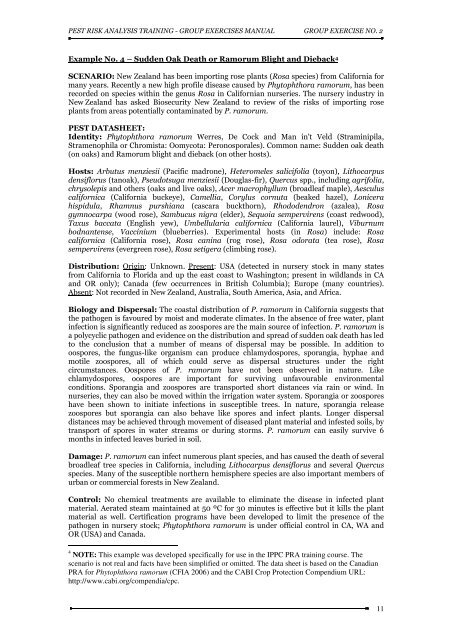PEST RISK ANALYSIS (PRA) TRAINING Group Exercises Manual
PEST RISK ANALYSIS (PRA) TRAINING Group Exercises Manual
PEST RISK ANALYSIS (PRA) TRAINING Group Exercises Manual
You also want an ePaper? Increase the reach of your titles
YUMPU automatically turns print PDFs into web optimized ePapers that Google loves.
<strong>PEST</strong> <strong>RISK</strong> <strong>ANALYSIS</strong> <strong>TRAINING</strong> - GROUP EXERCISES MANUAL GROUP EXERCISE NO. 2<br />
Example No. 4 – Sudden Oak Death or Ramorum Blight and Dieback 4<br />
SCENARIO: New Zealand has been importing rose plants (Rosa species) from California for<br />
many years. Recently a new high profile disease caused by Phytophthora ramorum, has been<br />
recorded on species within the genus Rosa in Californian nurseries. The nursery industry in<br />
New Zealand has asked Biosecurity New Zealand to review of the risks of importing rose<br />
plants from areas potentially contaminated by P. ramorum.<br />
<strong>PEST</strong> DATASHEET:<br />
Identity: Phytophthora ramorum Werres, De Cock and Man in't Veld (Straminipila,<br />
Stramenophila or Chromista: Oomycota: Peronosporales). Common name: Sudden oak death<br />
(on oaks) and Ramorum blight and dieback (on other hosts).<br />
Hosts: Arbutus menziesii (Pacific madrone), Heteromeles salicifolia (toyon), Lithocarpus<br />
densiflorus (tanoak), Pseudotsuga menziesii (Douglas-fir), Quercus spp., including agrifolia,<br />
chrysolepis and others (oaks and live oaks), Acer macrophyllum (broadleaf maple), Aesculus<br />
californica (California buckeye), Camellia, Corylus cornuta (beaked hazel), Lonicera<br />
hispidula, Rhamnus purshiana (cascara buckthorn), Rhododendron (azalea), Rosa<br />
gymnocarpa (wood rose), Sambucus nigra (elder), Sequoia sempervirens (coast redwood),<br />
Taxus baccata (English yew), Umbellularia californica (California laurel), Viburnum<br />
bodnantense, Vaccinium (blueberries). Experimental hosts (in Rosa) include: Rosa<br />
californica (California rose), Rosa canina (rog rose), Rosa odorata (tea rose), Rosa<br />
sempervirens (evergreen rose), Rosa setigera (climbing rose).<br />
Distribution: Origin: Unknown. Present: USA (detected in nursery stock in many states<br />
from California to Florida and up the east coast to Washington; present in wildlands in CA<br />
and OR only); Canada (few occurrences in British Columbia); Europe (many countries).<br />
Absent: Not recorded in New Zealand, Australia, South America, Asia, and Africa.<br />
Biology and Dispersal: The coastal distribution of P. ramorum in California suggests that<br />
the pathogen is favoured by moist and moderate climates. In the absence of free water, plant<br />
infection is significantly reduced as zoospores are the main source of infection. P. ramorum is<br />
a polycyclic pathogen and evidence on the distribution and spread of sudden oak death has led<br />
to the conclusion that a number of means of dispersal may be possible. In addition to<br />
oospores, the fungus-like organism can produce chlamydospores, sporangia, hyphae and<br />
motile zoospores, all of which could serve as dispersal structures under the right<br />
circumstances. Oospores of P. ramorum have not been observed in nature. Like<br />
chlamydospores, oospores are important for surviving unfavourable environmental<br />
conditions. Sporangia and zoospores are transported short distances via rain or wind. In<br />
nurseries, they can also be moved within the irrigation water system. Sporangia or zoospores<br />
have been shown to initiate infections in susceptible trees. In nature, sporangia release<br />
zoospores but sporangia can also behave like spores and infect plants. Longer dispersal<br />
distances may be achieved through movement of diseased plant material and infested soils, by<br />
transport of spores in water streams or during storms. P. ramorum can easily survive 6<br />
months in infected leaves buried in soil.<br />
Damage: P. ramorum can infect numerous plant species, and has caused the death of several<br />
broadleaf tree species in California, including Lithocarpus densiflorus and several Quercus<br />
species. Many of the susceptible northern hemisphere species are also important members of<br />
urban or commercial forests in New Zealand.<br />
Control: No chemical treatments are available to eliminate the disease in infected plant<br />
material. Aerated steam maintained at 50 ºC for 30 minutes is effective but it kills the plant<br />
material as well. Certification programs have been developed to limit the presence of the<br />
pathogen in nursery stock; Phytophthora ramorum is under official control in CA, WA and<br />
OR (USA) and Canada.<br />
4 NOTE: This example was developed specifically for use in the IPPC <strong>PRA</strong> training course. The<br />
scenario is not real and facts have been simplified or omitted. The data sheet is based on the Canadian<br />
<strong>PRA</strong> for Phytophthora ramorum (CFIA 2006) and the CABI Crop Protection Compendium URL:<br />
http://www.cabi.org/compendia/cpc.<br />
11













